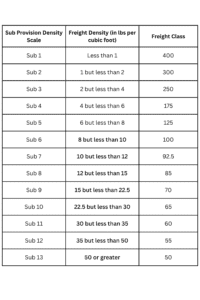Major changes are coming to LTL shipping in 2025, and understanding freight class, NMFC codes, and how to calculate freight class by density is crucial for every shipper. NMFC codes are the foundation of freight class codes, directly impacting pricing, handling, and compliance for Less-Than-Truckload (LTL) freight. With the NMFTA moving to a more streamlined, density-based classification system this summer, now is the time to ensure you know how to determine freight class, use a freight class chart, and leverage NMFC code lookup tools to stay compliant and save on shipping.
What is Freight Class? Why NMFC Codes Matter
Freight class is a standardized way to categorize LTL shipments using NMFC codes. Each NMFC number corresponds to a specific commodity, and the assigned class determines your shipping price and how carriers handle your freight. NMFC classification is based on four main factors:
- Density – The shipment’s weight relative to its size.
- Handling – Any special requirements for loading, unloading, or transport.
- Stowability – How easily the item fits in a trailer and with other loads.
- Liability – The risk of damage, theft, or loss.
Lower freight class codes (like class 50) generally mean your freight is dense, easy to handle, and low risk—resulting in lower rates. Higher freight classes (up to class 500) apply to lighter, bulkier, or more fragile goods.
The 2025 NMFC Changes: Freight Class by Density Becomes the New Standard
Starting July 19, 2025, the NMFTA is rolling out the most significant NMFC classification update in years. Here’s what’s changing:
- NMFC class codes for most general commodities, where handling, stowability, and liability are not a major factor will now be based primarily on density—not just commodity type.
- A new 13-tier density-based freight class chart replaces the old 11-tier system, introducing new classes 50 and 55 for the densest shipments.
- Over 2,000 NMFC items are being simplified—making it easier to use a NMFC lookup tool or NMFC calculator to determine freight class.
- Freight with special handling, stowability, or liability needs will be flagged with new identifiers.
Accurate use of a freight class by density chart and NMFC class lookup is now more important than ever. Carriers are using advanced dimensioning equipment and scales—so precise measurements are critical to avoid reclassification, delays, and extra charges.
Freight Class by Density Chart: 2025 NMFC Density-Based Freight Classes
To determine your LTL freight class shippers need to do an analysis of the NMFC number to determine if it is moving to a density calculation or if it is staying the same class by using the NMFC Lookup Tool.
Once the shipper has determined if a new Class is assigned and determined it is density based, use the updated freight class by density chart below. This density based freight class chart is central to the new NMFC classification and NMFC density-based freight rating.

Classes 50 and 55 are brand new for 2025, rewarding shippers of highly dense freight with lower rates.
How to Calculate Freight Class: The Freight Density Formula
To use a LTL freight class calculator or NMFC calculator, you’ll first need to calculate your shipment’s density:
Freight Density Formula:
- Measure: Carefully measure the length, width, and height of your fully packaged shipment in inches.
- Multiply: Multiply these dimensions (L x W x H) to get total cubic inches.
- Convert to Cubic Feet: Divide by 1,728 (the number of cubic inches in a cubic foot).
- Divide Weight by Volume: Divide the total weight (in pounds) by the cubic feet.
Density = weight (lbs) / total cubic feet
Example:
– Shipment weighs 500 lbs
– Dimensions: 48″ x 40″ x 36″
– Cubic inches: 48 x 40 x 36 = 69,120
– Cubic feet: 69,120 / 1,728 = 40
– Density: 500 / 40 = 12.5 lbs per cubic foot
This would correspond to NMFC Class 85 in the new freight class by density chart.
Why Accurate Measurements Matter More Than Ever
With the 2025 NMFC classification, shippers must be exact. Many LTL carriers now use visioning technology and precision scales to verify your declared dimensions and weight. If your numbers are off, the carrier’s NMFC class calculator will automatically reclassify your shipment—potentially increasing costs and delaying delivery.
Tips:
- Use a reliable freight density calculator before booking.
- Double-check all weights and dimensions.
- Utilize the NMFTA’s NMFC lookup tool to find current NMFC codes and NMFC numbers.
How to Determine Freight Class and Use NMFC Lookup Tools
- Start by using the NMFTA Item Lookup Tool to find your commodity’s NMFC number.
- Apply the freight density formula to get the correct LTL freight class.
- Reference the freight class by density chart to finalize your classification.
Supply Chain Solutions: Your Partner for the New NMFC Classifications
Supply Chain Solutions is ready for the NMFC changes. We can help you:
- Evaluate your current freight class codes and NMFC codes.
- Identify opportunities for LTL savings as the new density-based system goes live.
- Use our marketplace tools to compare rates across multiple carriers and find the best value.
- Ensure your processes and documentation are ready for compliance—helping you avoid reclassification fees and delays.
If you want to maximize your shipping efficiency and stay ahead in the new NMFC era, contact us today.
Frequently Asked Questions – Freight Class, NMFC Codes, and Density Calculators
What is a freight class chart and how do I use it?
A freight class chart is a reference table that matches different ranges of freight density (measured in pounds per cubic foot) to specific NMFC classes. You use it to determine your shipment’s class after calculating its density, which helps ensure accurate pricing and compliance.
How do I use an NMFC code lookup tool?
An NMFC code lookup tool lets you search for your commodity’s NMFC number and corresponding class based on its description. The NMFTA Item Lookup Tool is the official source for shippers to determine the correct NMFC code.
How many freight class codes are there in the NMFC system?
There are 18 official freight class codes, ranging from class 50 (for the densest freight) up to class 500 (for the least dense, most difficult-to-handle items). The 2025 update introduces new density classes to improve accuracy.
What is the best way to determine freight class for my shipment?
The best way to determine freight class is to calculate your shipment’s density using a freight density formula, then reference the current freight class by density chart. For added accuracy, use an NMFC class calculator or consult with your carrier or logistics partner.
How do I use a freight density calculator?
A freight density calculator takes your shipment’s weight and dimensions to compute its density in pounds per cubic foot. This result is then matched to the correct class on the freight class by density chart, ensuring your shipment is classified properly for LTL shipping.
What is an NMFC class lookup and why is it important?
An NMFC class lookup is the process of finding your commodity’s official NMFC number and assigned freight class. Using a trusted NMFC lookup tool helps prevent errors, billing disputes, and delays.
How can I avoid extra charges with the new NMFC density based freight rules?
To avoid extra charges, always provide accurate weight and dimensions, use a freight density calculator, and verify your NMFC code with the latest NMFC code lookup tools. Carriers are using advanced technology to check your data, so accuracy is critical.
Contact Supply Chain Solutions to review your freight classification strategy and ensure you’re ready for the 2025 NMFC transition.

